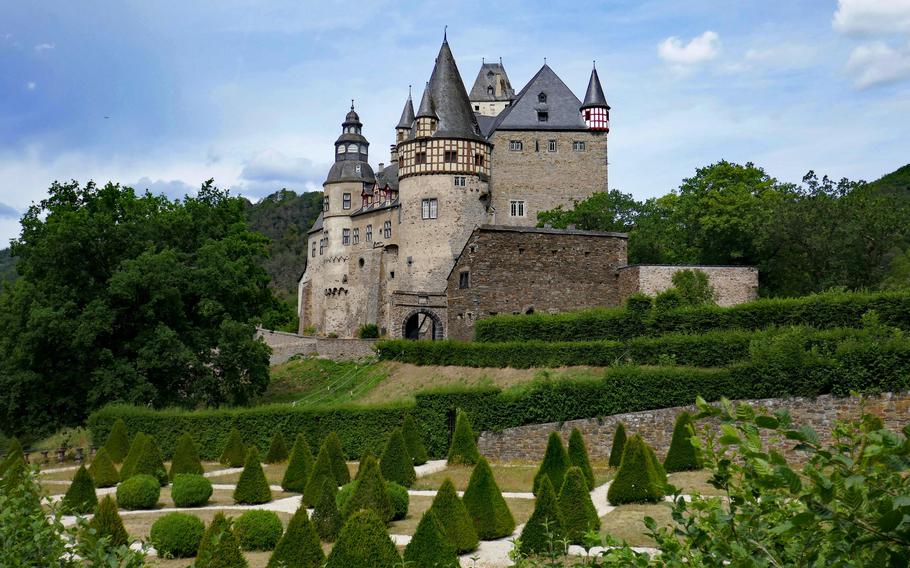
Buerresheim Castle stands high on a rocky outcrop near Mayen, Germany. The kitchen garden, shown in the foreground, is not open to the public. (Michael Abrams/Stars and Stripes)
Tucked away in the green forests of western Germany’s Eifel region is Buerresheim Castle, an imposing fortress high on a rocky promontory that was built late in the 12th century.
Movie fans might recognize Buerresheim from “Indiana Jones and the Last Crusade.” Its exterior was used as the fictional Castle Brunwald, where Indy rescues his dad from the Nazis. The interiors were shot elsewhere.
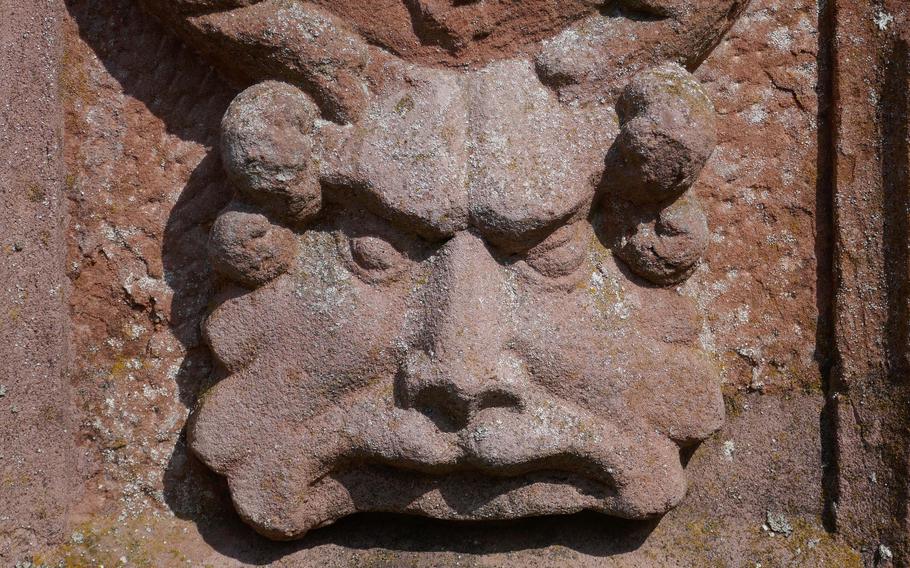
This not-so-friendly-looking guy adorns a column in front of Buerresheim Castle in Germany’s Eifel region. (Michael Abrams/Stars and Stripes)
Like many medieval castles in Germany, this one changed hands over the years, and one of these ownership transfers even led to a division of the castle in two.
Because the border of two archdioceses ran through the fortress, Buerresheim Castle was split into the Koelner Burg, owned by the archbishop of Cologne, and the Trierer Burg, belonging to his counterpart in Trier.
Later, the whole castle came into the possession of the noble von Breidbach family. Koelner Burg was abandoned and now is in ruins, but Trierer Burg was kept up and expanded. Today, it is a melange of towers, turrets, gables and mighty walls.
Despite the many owners, one thing sets Buerresheim Castle apart from many others in Germany: It never was taken or destroyed in battle.
Trierer Burg now consists of two buildings, the medieval fortress and the half-timbered Baroque residence. A tour is the only way to see inside, and visitors travel from the 15th century to the 20th century in the process.
They see the expansive old kitchen, which was the center of medieval life in the castle. The hunting room, like many others, is adorned with trophy antlers. The knights hall features two giant Flemish tapestries.
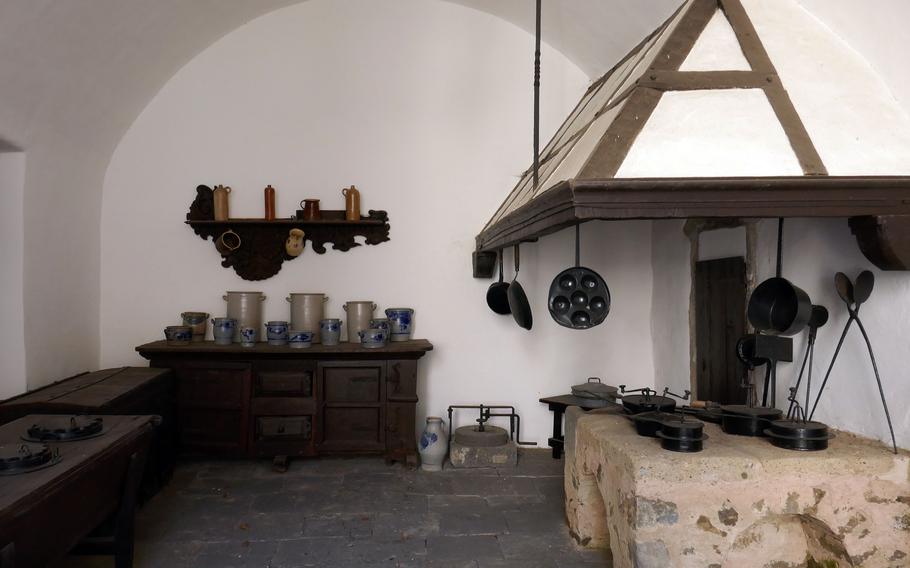
The summer kitchen at Buerresheim Castle, with its half-timbered oven. (Michael Abrams/Stars and Stripes)
Nearby is the chapel. The glass discs in its windows are from the 13th century but were installed here in the 19th century. The tour ends in the Baroque amtshaus. In the ancestral hall is a gallery of family portraits of the castle’s owners.
What makes Buerresheim so interesting is it was lived in continuously for centuries, and about 90% of the items displayed are original to their surroundings and were used by the inhabitants.
The last owner of the castle, Elisabeth von Westerholt-Gysenberg, lived there until she sold it in its entirety to the Prussian Rhineland Province in 1938. Following World War II, it fell to the state of Rheinland-Pfalz.
Visible in a large early 18th-century painting of the castle is a small town. This was Mayen, which still has a medieval feel, with narrow cobblestoned lanes, half-timbered buildings and an expansive market square.
It even has a castle, the Genovevaburg. Built in 1280, it has, unlike Buerresheim, been destroyed many times. Today, it hosts theater performances in the summer.
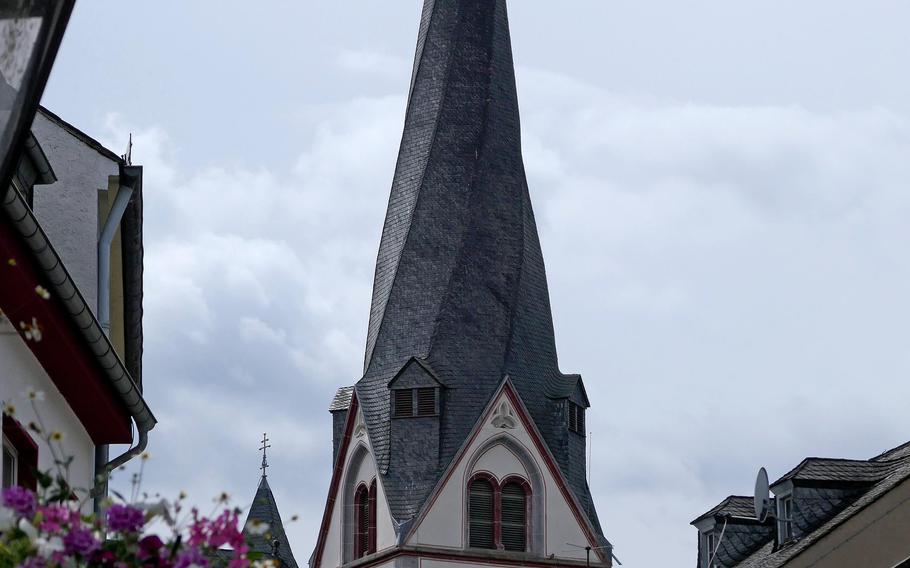
St. Clemens Church in Mayen, Germany, with its crooked steeple. Experts attribute the shape to construction errors. (Michael Abrams/Stars and Stripes)
A curious sight in Mayen is the misshapen steeple of St. Clemens Church. Experts attribute its crookedness to construction errors that left it 5.5 feet out of balance.
But according to legend, when the devil was fooled by residents into helping build the church, he became angry and tried to tear down the steeple. He managed to get in only the twist seen today before the saint stopped him.
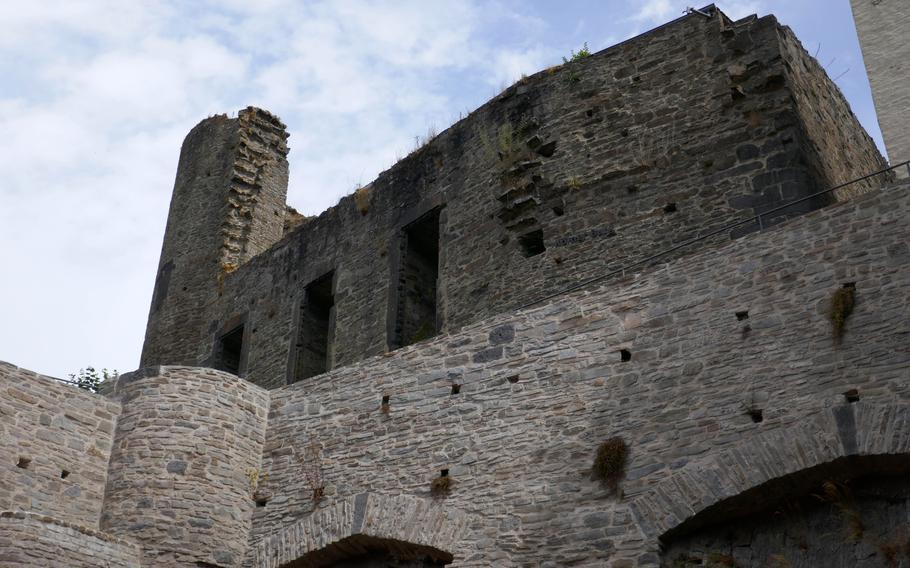
The ruins of the Koelner Burg, one of the two former fortresses that make up Buerresheim Castle. Trierer Burg can still be visited. Koelner Burg, on the other hand, was abandoned and fell into a dilapidated state. (Michael Abrams/Stars and Stripes)
On the QT:
Directions: Use Schloss Buerresheim as the destination in navigation devices. The castle and Mayen are about 80 miles from Wiesbaden and about 60 miles from Spangdahlem.
Times: 10 a.m.-5 p.m. Saturday, Sunday and German holidays, Feb. 1 to March 14; 10 a.m.-6 p.m. Thursday through Sunday, March 15 to Oct. 31; and 10 a.m.-5 p.m. Saturday, Sunday and German holidays in November. Closed in December and January. Last entrance is one hour before closing. Access to the inside of Buerresheim Castle is by tour only. The first tour starts at about 10:45 a.m. A guide booklet sold on site for 2.50 euros is worth buying. All tours are in German.
Costs: Admission is 5 euros for adults and 3 euros for children 7 and older. Parking at the castle is free. Expect to pay about 1.50 euros per hour for parking in Mayen.
Information: https://kulturerbe-eifel-mosel.de/en/buerresheim-castle/, www.mayen.de. Photography is not allowed on the tour.